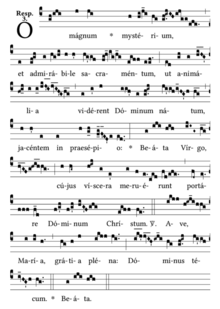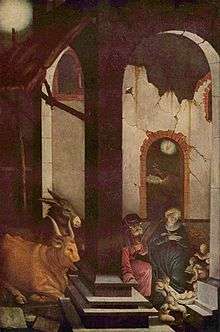O magnum mysterium
O magnum mysterium is a responsorial chant from the Matins of Christmas.


Text
- Latin text
- O magnum mysterium,
- et admirabile sacramentum,
- ut animalia viderent Dominum natum,
- iacentem in praesepio!
- Beata Virgo, cujus viscera
- meruerunt portare
- Dominum Iesum Christum.
- Alleluia!
- English translation
- O great mystery,
- and wonderful sacrament,
- that animals should see the newborn Lord,
- lying in a manger!
- Blessed is the virgin whose womb
- was worthy to bear
- the Lord, Jesus Christ.
- Alleluia!
History
The image of the oxen and donkey next to the crib is found in Isaiah (Isa. 1.3) and is traditionally related to the nativity scene at the birth of Jesus in Luke 2. Luke (Lk 2.7) does not mention animals, but a manger. In the apocryphal Gospel of Pseudo-Matthew, both animals are specifically named. The image continued to spread from the 13th century onwards when it was included in the Golden Legend. It became the most popular symbol for the mystery of the self-abasement of God in his Incarnation. (Phil 2,6–7).
The second part of the responsory relates to the words with which Elizabeth welcomes Mary, mother of Jesus on her visitation (Lk 1.42–43).
O Magnum Mysterium (Morten Lauridsen)
Composed in 1994 by Morten Lauridsen, American composer. The piece mimics classic Gregorian choral pieces in its style but with some modern influence as well. Speaking of the piece Lauridsen said "I wanted this piece to resonate immediately and deeply into the core of the listener, to illumine through sound.[1]" The music pulls its lyrics from the responsorial chant shown above. Lauridsen accounts that his inspiration for the piece came from a painting he saw in the Norton Simon Museum titled “Still Life with Lemons, Oranges and a Rose” (1633) by Spanish Baroque artist Francisco de Zurbarán, which Lauridsen said was symbolism for the Virgin Mary. Lauridsen said he worked on the piece over a period of six months and put considerable thinking into a certain dissonant note to comment on the sorrow that the Virgin Mary would later face as her son was killed.[2]
References
- "Morten Lauridsen: O Magnum Mysterium". Classic FM. Retrieved 2019-11-17.
- Morten Lauridsen: "O Magnum Mysterium", retrieved 2019-11-17
External links
| Wikimedia Commons has media related to O magnum mysterium. |
- O magnum mysterium: Text, translations and list of free scores by several composers at the Choral Public Domain Library (ChoralWiki)
- O Magnum Mysterium by Grex Vocalis
- O magnum mysterium on YouTube by Morten Lauridsen sung by the Choir of King's College, Cambridge University
- O magnum mysterium on YouTube by Morten Lauridsen sung by Lumen Valo
- O magnum mysterium on YouTube by Tomás Luis de Victoria
- O magnum mysterium on YouTube by Giovanni Gabrieli
- O magnum mysterium on YouTube by Giovanni Pierluigi da Palestrina
- O magnum mysterium on YouTube by Francis Poulenc
- O magnum mysterium on YouTube by Margaret Rizza
- O magnum mysterium on YouTube by Ivo Antognini
- O magnum mysterium on YouTube by Manolo Da Rold
- O magnum mysterium (Serenity) on YouTube by Ola Gjeilo
- O magnum mysterium on YouTube by Chris Artley
- O magnum mysterium on YouTube by Kevin Memley
- O magnum mysterium on YouTube by David Conte
- O magnum mysterium on YouTube Concert Band Version Arranged by H. Robert Reynolds
- O magnum mysterium on YouTube by Linda Ronstadt